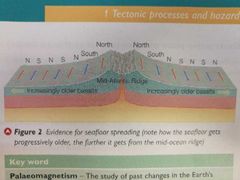![]()
![]()
![]()
Use LEFT and RIGHT arrow keys to navigate between flashcards;
Use UP and DOWN arrow keys to flip the card;
H to show hint;
A reads text to speech;
6 Cards in this Set
- Front
- Back
|
Plate-Tectonic Theory: Mantle Convection |
Mantle convection has long bren thought responsible for plate movement, but this argument is now less accepted In mantle convection, heat produced by the decay of radioactive elements in the Earth's core heats the lower mantle - creating convection currents These hot, liquid magma currents are thought to move in circles in the asthenosphere - thus causing the plates to move |
|
|
Slab Pull |
Today, slab pull is increasingly being seen as a major driving force for plate movement Newely formed oceanic crust at mid-ocean ridges becomes denser and thicker as it cools This causes it to sink into the mantle under its own weight - pulling the rest of the plate further down with it |
|
|
Subduction |
Seafloor spreading raises a question: if new crust is being created, the Earth should be expanding - but it isn't This is because, as new crust is being created in one place, it's being destroyed in another - by subduction As two oceanic plates, or an oceanic plate and a continental plate move towards each other, one slides under the other into the mantle - where it melts in an area known as a subduction zone |
|
|
Seafloor Spreading |
In the middle of many oceans are huge mid-ocean ridges, or underwater mountain ranges These are formed when hot magma is forced up from the asthenosphere and hardens - forming new oceanic crust This new crust pushes the tectonic plates apart in a process called seafloor spreading |
|
|
Palaeomagnetism in seafloor spreading |

In the 1950's, studies of palaeomagnetism confirmed that the seafloor was spreading Every 400,000 years or so, the Earth's magnetic fieldschange direction - causing the magnetic north and south poles to swap When lava cools and becomes rock, minerals inside the rock line up with the Earth's magnetic direction (polarity) at the time Scientists studying mid-ocean ridges found the same pattern of magnetic direction on either side of the ridges (something that could only happen if new rock was being formed at the same time on both sides) |
|
|
Palaeomagnetism |
The study of past changes in the Earth's magnetic field, determined from rocks, sediment or archaeological records |

